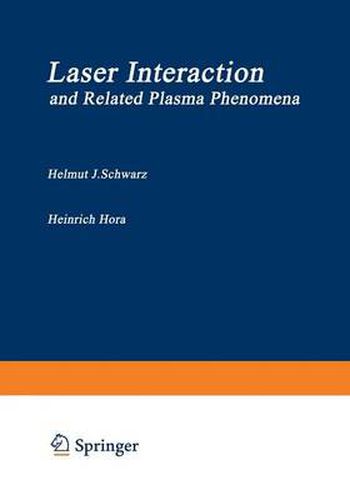Readings Newsletter
Become a Readings Member to make your shopping experience even easier.
Sign in or sign up for free!
You’re not far away from qualifying for FREE standard shipping within Australia
You’ve qualified for FREE standard shipping within Australia
The cart is loading…






This title is printed to order. This book may have been self-published. If so, we cannot guarantee the quality of the content. In the main most books will have gone through the editing process however some may not. We therefore suggest that you be aware of this before ordering this book. If in doubt check either the author or publisher’s details as we are unable to accept any returns unless they are faulty. Please contact us if you have any questions.
Since the third Workshop on Laser Interaction and Related Plasma Phenomena in 1973, one area within the scope of this con ference received increased attention: laser fusion. This possi bility was emphasized in February 1977 in a Seminar on US energy policies at The Hartford Graduate Center by John F. O'Leary, Head of the Federal Energy Administration, who said that by the year 2100, laser fusion will be coming along, giving us a new age of choice. Efforts in research and development were stepped up to investigate new concepts of laser ignition of controlled nuclear reactions. Here, one expects no radioactive waste from fuel. The deuterium-tritium reaction - the only one which may be possible with magnetic field confinement in tokamaks - has a highly radio active tritium ycle, while, in principle, laser reactions are possible with pure deuterium, hydrogen-boron or others. The worldwide progress in laser compression was not only stim ulated by the energy crisis, but also by its advancements. In our first Workshop in 1969 F. F10ux of the French Limei1 Laboratories described his experiments, which led, only one month later, to the production of fusion neutrons in such large numbers as had not been achieved up to then (see appendix of Vol. I these Proceedings).
$9.00 standard shipping within Australia
FREE standard shipping within Australia for orders over $100.00
Express & International shipping calculated at checkout
This title is printed to order. This book may have been self-published. If so, we cannot guarantee the quality of the content. In the main most books will have gone through the editing process however some may not. We therefore suggest that you be aware of this before ordering this book. If in doubt check either the author or publisher’s details as we are unable to accept any returns unless they are faulty. Please contact us if you have any questions.
Since the third Workshop on Laser Interaction and Related Plasma Phenomena in 1973, one area within the scope of this con ference received increased attention: laser fusion. This possi bility was emphasized in February 1977 in a Seminar on US energy policies at The Hartford Graduate Center by John F. O'Leary, Head of the Federal Energy Administration, who said that by the year 2100, laser fusion will be coming along, giving us a new age of choice. Efforts in research and development were stepped up to investigate new concepts of laser ignition of controlled nuclear reactions. Here, one expects no radioactive waste from fuel. The deuterium-tritium reaction - the only one which may be possible with magnetic field confinement in tokamaks - has a highly radio active tritium ycle, while, in principle, laser reactions are possible with pure deuterium, hydrogen-boron or others. The worldwide progress in laser compression was not only stim ulated by the energy crisis, but also by its advancements. In our first Workshop in 1969 F. F10ux of the French Limei1 Laboratories described his experiments, which led, only one month later, to the production of fusion neutrons in such large numbers as had not been achieved up to then (see appendix of Vol. I these Proceedings).